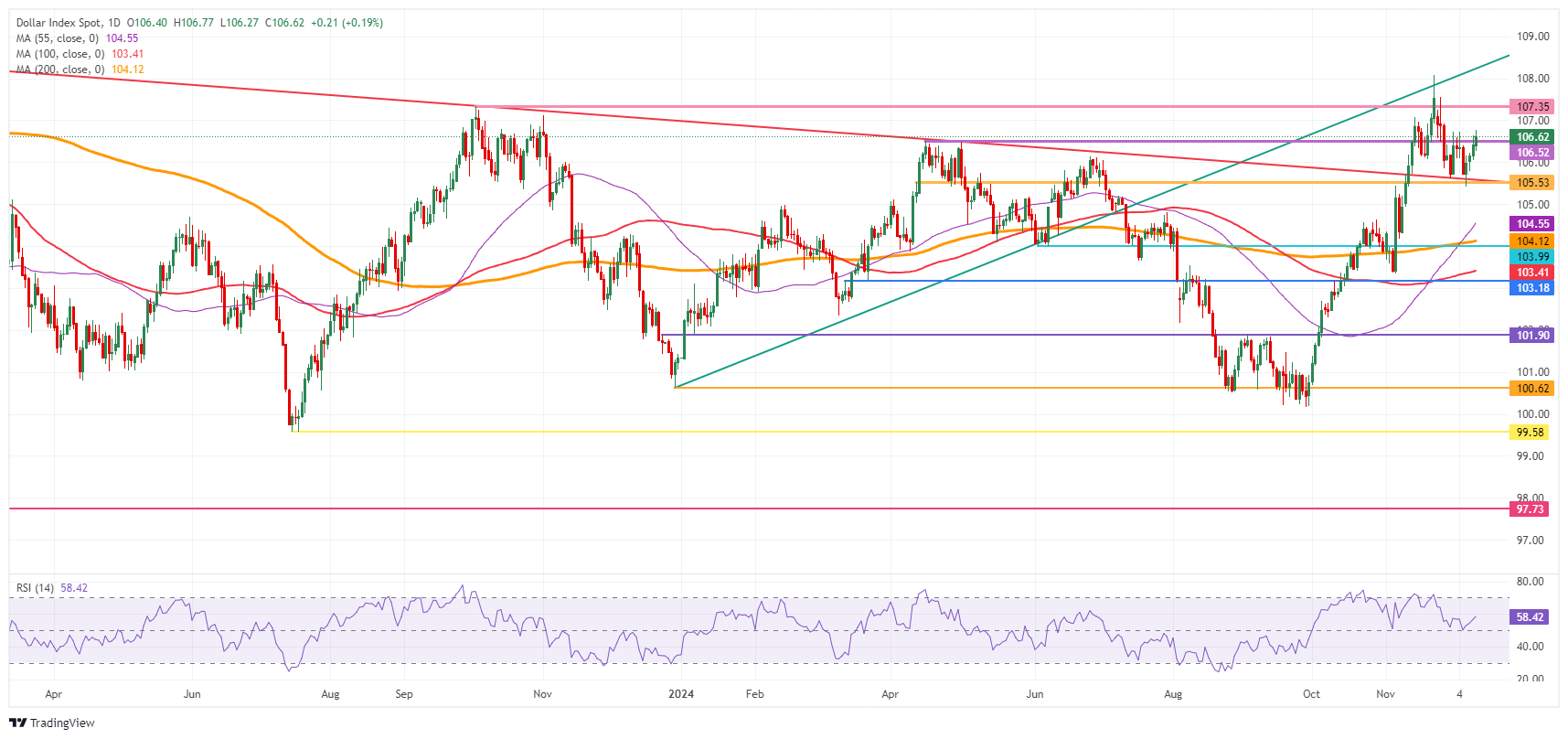US Dollar keeps gains ahead of US CPI data, key for determining Fed outcome
- The US Dollar edges up slightly ahead of the US CPI report for November.
- Traders have already sent the US Dollar higher amidst heightened expectations for an above-expectations number.
- The US Dollar Index (DXY) is trading around 106.50 and has its eye on 107.00 on the upside.
The US Dollar (USD) edges up on Wednesday, extending the winning streak that started on Friday. The Greenback is enjoying some safe-haven inflows on the back of recent events in Syria after former President Bashar al-Assad fled the country as the rebels took control. This adds to nervousness over the thin equilibrium of peace that resides in the region after Israel and Hezbollah agreed to a ceasefire.
The main element on Wednesday’s economic calendar is the US Consumer Price Index (CPI) release. The monthly CPI release for both the headline and the core will catch the most attention. Any reading that exceeds expectations could diminish expectations for an interest-rate cut by the Federal Reserve (Fed) next week.
Daily digest market movers: CPI last print to decide
- At 13:30 GMT, the US Consumer Price Index (CPI) release for November will be released:
- The monthly headline Inflation is expected to head to 0.3%, from 0.2%. The yearly gauge should tick up to 2.7% from 2.6%.
- The monthly core inflation should increase by 0.3%, the same pace as the previous month. The yearly core measure should also steady at 3.3%.
- Any print below consensus will likely weaken the US Dollar as odds for a Fed rate cut next week would rise. On the contrary, a reading above consensus will diminish rate-cutting odds and should spark some more US Dollar appreciation.
- Equities are struggling this Wednesday with investors worried about the geopolitical tensions that are flaring up in the Middle East. European indices are down overall by less than 0.50%. US Futures are trading rather flat.
- The CME FedWatch Tool is pricing in another 25 basis points (bps) rate cut by the Fed at the December 18 meeting by 86.1%. A 13.9% chance is for rates to remain unchanged.
- The US 10-year benchmark rate trades at 4.23%, retreating a touch from its peak this week at 4.24% on Tuesday.
US Dollar Index Technical Analysis: Ranging in bandwidth
The US Dollar Index (DXY) is defining a bandwidth that could hold until next year given the limited amount of data points left. The US Consumer Price Index (CPI) release will likely determine if that bandwidth will be between 105.50 and 107.00 or between 105.50 and 108.00.
US Dollar bulls have reclaimed 106.52 (April 16 high), which was a hard bargain to get through. Next up is the 107.00 round level and 107.35 (October 3, 2023, high). Further up, the high of November 22 at 108.7 emerges.
Looking down, the pivotal level at 105.53 (April 11 high) comes into play before heading into the 104-region. Should the DXY fall all the way towards 104.00, the big figure and the 200-day Simple Moving Average at 104.03 should catch any falling knife formation.
US Dollar Index: Daily Chart
Inflation FAQs
Inflation measures the rise in the price of a representative basket of goods and services. Headline inflation is usually expressed as a percentage change on a month-on-month (MoM) and year-on-year (YoY) basis. Core inflation excludes more volatile elements such as food and fuel which can fluctuate because of geopolitical and seasonal factors. Core inflation is the figure economists focus on and is the level targeted by central banks, which are mandated to keep inflation at a manageable level, usually around 2%.
The Consumer Price Index (CPI) measures the change in prices of a basket of goods and services over a period of time. It is usually expressed as a percentage change on a month-on-month (MoM) and year-on-year (YoY) basis. Core CPI is the figure targeted by central banks as it excludes volatile food and fuel inputs. When Core CPI rises above 2% it usually results in higher interest rates and vice versa when it falls below 2%. Since higher interest rates are positive for a currency, higher inflation usually results in a stronger currency. The opposite is true when inflation falls.
Although it may seem counter-intuitive, high inflation in a country pushes up the value of its currency and vice versa for lower inflation. This is because the central bank will normally raise interest rates to combat the higher inflation, which attract more global capital inflows from investors looking for a lucrative place to park their money.
Formerly, Gold was the asset investors turned to in times of high inflation because it preserved its value, and whilst investors will often still buy Gold for its safe-haven properties in times of extreme market turmoil, this is not the case most of the time. This is because when inflation is high, central banks will put up interest rates to combat it. Higher interest rates are negative for Gold because they increase the opportunity-cost of holding Gold vis-a-vis an interest-bearing asset or placing the money in a cash deposit account. On the flipside, lower inflation tends to be positive for Gold as it brings interest rates down, making the bright metal a more viable investment alternative.

